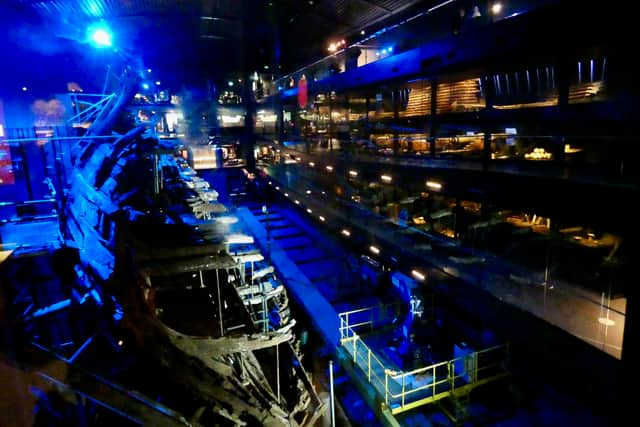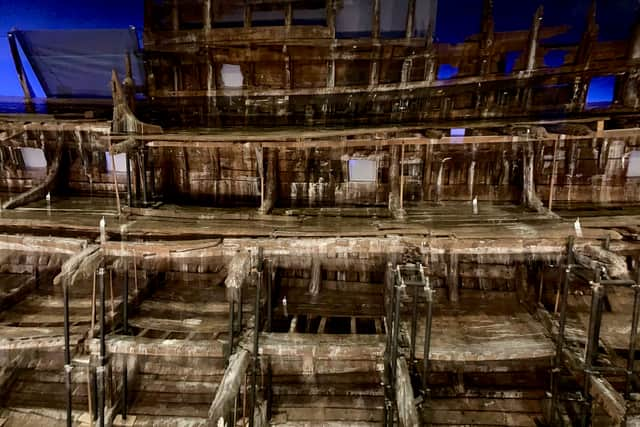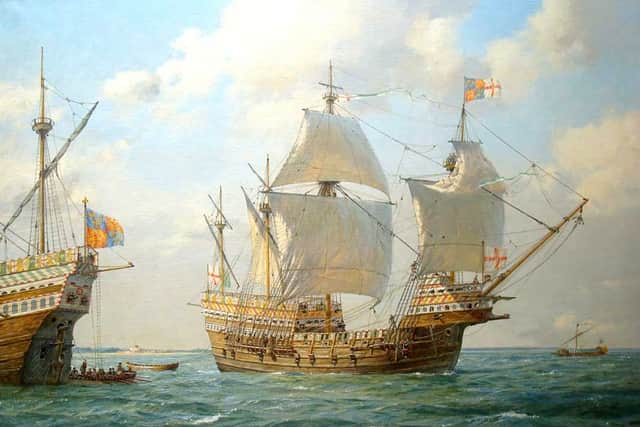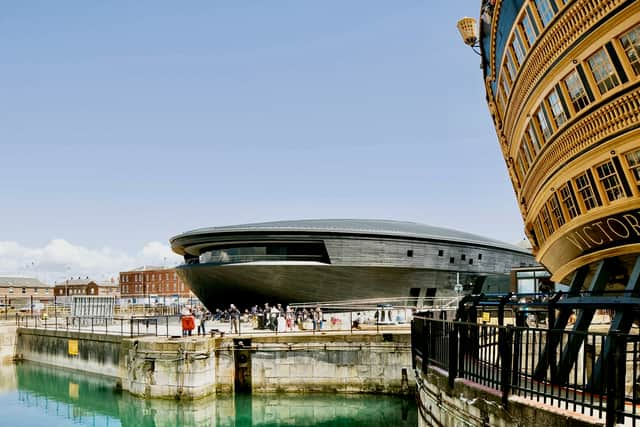We visited Henry VIII’s flagship Mary Rose raised by Black Country engineers & it was full of mystery
and live on Freeview channel 276
It was a tragedy, certainly. And it could have been a national catastrophe. As the French fleet swaggered into the mouth of the Solent on July 19, 1545, things looked bleak. All that stood between them and the invasion of England was Henry VIII’s flagship, Mary Rose, and the outnumbered vessels of the king’s Navy.
Then, the unimaginable happened. To this day no-one is sure why, but Mary Rose keeled over during a tight turn and sank beneath the waves. Despite the loss, the defending forces rallied and battled bravely, and the French retreated on July 22. Mary Rose would not be seen again for more than 400 years.
Advertisement
Hide AdAdvertisement
Hide AdShe rose again from the chill grip of the sea bed in October 1982. Now, in May 2023, I stand before the ship of which Henry was so proud. If you haven’t been here before, nothing quite prepares you for your first sight of Mary Rose, painstakingly pieced back together and bathed in blue light, at the remarkable museum which bears her name in Portsmouth Historic Dockyard.
Still towering tall, the king’s flagship evokes a surprisingly strong emotional response. She’ll surely shiver your timbers. Yes, the salvaged artefacts – no fewer than 19,000 have been recovered so far – are remarkable, ranging from a huge cannon to a tiny carpenter’s comb. The many that you see in the atmospherically lit galleries are just the tip of an iceberg.
Yes, the occasional projections of day-to-day maritime life beamed onto the ship are clever, adding context to the story. The museum itself is quite beautiful and the added 21st century tech immersive. But there’s never any doubting the star of the show. Mary Rose herself.
This was my third visit to the 16th century warship. The museum opened in 1984 and I first dropped in a few years later when you could get tantalising glimpses of the ship only through plastic sheeting and incessant mists of timber-preserving water.
Advertisement
Hide AdAdvertisement
Hide AdI returned in 2016, three years after the eye-catching new building, shaped like a ship’s hull, opened. This time, I was able to view clearly the reclaimed hull from glass-windowed walkways set opposite each of the main decks. It was wonderful.
Now, the Mary Rose Trust has upped the ante again. Those walkways offer even better views than before; there’s a pre-show passage with voiceovers by Dame Judi Dench and a virtual Henry VIII; a just-opened 4D special effects theatre adds to the experience.


So, what should you expect?
You’ll find the museum 400 metres from the entrance to Portsmouth Historic Dockyard, the ship-shaped structure coming in to view as you round the stern of HMS Victory. Entrance is by way of a foyer which also opens out into a gift shop and coffee bar.
Step through a curtain and you find yourself virtually walking on water in an audio-visual walkthrough titled 1545: When Their World Ended. Another national treasure, Dame Judi Dench, sets the scene, Henry VIII talks of Mary Rose being his pride and joy – and then the French fleet shows up.
Advertisement
Hide AdAdvertisement
Hide AdYou find yourself looking through portholes on either side as the ship sails into battle in the Solent before executing a tight left turn and, before you know it, water comes flooding in to starboard. Rest assured, you’re still on terra firma – this sinking is strictly CGI.
But it’s a foreboding taste of the full story. As you tour the galleries set at each end of the Mary Rose hall, you learn that netting stretched across the decks to deter boarders actually prevented most of the crew from escaping, leading to death by drowning.
Of the 200 sailors, 185 soldiers and 30 gunners reckoned to be on board, only 35 souls survived. The bones of 179 people have so far been found, suggesting that all were men, mostly under the age of 30 – and some were no more than 11 years old.
Little is known of their identities, although a cook’s belongings appear to bear his name, NY Coep, and dotted around the museum there are pictures of a handful of crew members, which have been reconstructed from skulls reclaimed by divers.
Advertisement
Hide AdAdvertisement
Hide AdMost of the artefacts have been remarkably preserved and often it’s the small, personal items that bring home the human face of the tragedy. There’s a carpenter’s comb and manicure set; a sailor’s early backgammon game, dice and tumbler.
Several small books are to be seen; there’s a bowed musical instrument; plates and drinking mugs have been personalised; there’s even a clay tile across which a dog has walked, leaving its paw print for us to see generations later.


Alongside the cannonballs, shot and arrows – more than 2,300 of the latter have been recovered pretty much intact – there are the instruments used by the ship’s surgeon; items recovered from the galley; everyday possessions that we take for granted today.
And, as if to prove that there are always more mysteries to be uncovered, there’s an as yet unidentified tool used by the ship’s carpenter which may, or may not, have been a ‘joggle stick’ used to transfer measurements from one piece of timber to another.
Advertisement
Hide AdAdvertisement
Hide AdLarger artefacts are to be found on your port side as you traverse the three glass-sided walkways in the main ship hall, all of which bow convincingly in the middle just like the Mary Rose decks, to the sounds of creaking timbers on a ship at sea.
A self-guided walk through the museum – audio tours and an interactive app are also available – finally leads you to the giddy heights of the top deck gallery where the museum’s most recent addition opened just a few weeks ago.
Dive The Mary Rose is a two-part attraction which opens with film footage telling the story of the quest leading up to the rediscovery of the wreck site (sometimes ‘X’ really does mark the spot) and confirmation of the fantastic find on May 1, 1971.
Visitors then enter a 4D theatre which seats around 40 people at a time, where a tale worthy of an Indiana Jones movie relates the subsequent exploration of the site, then the salvage and eventual raising of the ship to the surface 437 years after she sank.


Advertisement
Hide AdAdvertisement
Hide AdThe industrial Black Country of the UK’s West Midlands – where the Titanic’s anchor chains were made – was called upon once again for its ingenuity and two local firms, Tipton’s Babcock Power Construction and Barnshaws Section Bending in Tividale, created a cradle in which Mary Rose could sit.
The cradle would be lifted by a purpose-built frame raised inch-by-inch by the giant floating crane, Tog Mor. It was a salvage operation the likes of which the world had never seen before – and watch it, the world did.
The £4 million operation, on October 11, 1982, was viewed by 60 million people on live television and there was a heart-stopping moment when one of the pins holding the frame used to lift the ship in its giant cradle sheared and a steel line snapped.
There was a huge crash as part of the 80-ton frame smashed down on the hull and for an agonising moment, it seemed as if the raising of the Mary Rose would end in disaster. The world held its breath – and perhaps Henry VIII was looking on – as the ship stabilised.
Advertisement
Hide AdAdvertisement
Hide AdIt’s all told in a blend of crystal-clear CGI – the silted waters of the Solent meant that visibility was often next to non-existent – archive film footage and interviews, some impressive 3D swim-throughs and special effects including gusts of wind and bubbles.
You’ll need to wear the 3D glasses supplied, and be warned that seats vibrate to the loud sound of the salvage boat’s engines, and to impacts on the surface and underwater. It’s informative fun and, as one of the divers recalls, “like swimming into an Aladdin’s Cave”.
The presentation even shows the young Prince of Wales, who had supported the project throughout, making his first dive on the ship. Now King Charles III in this coronation year, the raising of the Mary Rose can be seen as a crowning glory of our maritime heritage.


A few things to bear in mind before you visit
Dive The Mary Rose is not suitable for children aged four years or younger, and kids under 12 must be accompanied by an adult. There are precautionary health warnings for those who are pregnant, prone to motion sickness or have back problems.
Advertisement
Hide AdAdvertisement
Hide AdIf you do not have a head for heights, the upper walkways alongside the ship may prove challenging, especially with the floor-to-ceiling glass windows. There are, however, alternative viewing points at each end of the hall.
Light levels are kept low inside the museum to help preserve the collection from UV and visible light that could damage items potentially beyond repair. Relaxed Opening mornings take place monthly, during which light levels are temporarily raised.
See the museum website, www.maryrose.org, for full details, together with opening hours and a wide range of admission prices. Best value is an Ultimate Explorer Season ticket which is valid for a year and includes all 11 of the attractions in the Historic Dockyard, including HMS Victory and harbour cruises.
The Mary Rose Museum will account for at least two hours – and in most cases much more – of your time, and I guarantee you won’t do justice to all the area’s attractions in a single day, no matter how much you may be tempted to rush.
Advertisement
Hide AdAdvertisement
Hide Ad* The Ultimate Explorer Season ticket, from £29, allows 12 months’ unlimited admission to: The Mary Rose Museum; HMS Victory; HMS Warrior; HMS M.33; the NMRN Galleries; the Explosion Museum of Naval Firepower; Royal Navy Submarine Museum; Action Stations!; Harbour Tours & Waterbus; Boathouse 4 and Dockyard Apprentice.
Comment Guidelines
National World encourages reader discussion on our stories. User feedback, insights and back-and-forth exchanges add a rich layer of context to reporting. Please review our Community Guidelines before commenting.